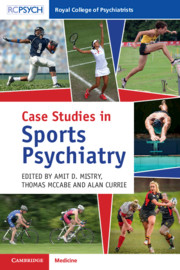Book contents
- Case Studies in Sports Psychiatry
- Reviews
- Case Studies in Sports Psychiatry
- Copyright page
- Contents
- Editors
- Contributors
- Foreword
- Preface
- Chapter 1 American Football: Cognitive Impairment
- Chapter 2 Athletics: Energy Levels, Exercise Addiction and Disordered Eating
- Chapter 3 Boxing: Low Mood and Gambling
- Chapter 4 Cricket: Mental Health Emergencies
- Chapter 5 Cycling: Attention Deficit Hyperactivity Disorder and Anti-Doping
- Chapter 6 Football: Alcohol and Barriers to Support
- Chapter 7 Golf: Alcohol, Anxiety and Sleep Problems
- Chapter 8 Rugby: Concussion and Mental Health Symptoms
- Chapter 9 Swimming: Adolescent Athlete Training Commitments
- Chapter 10 Tennis: Trauma and Tours
- Appendix: International Society for Sports Psychiatry Curriculum 2018
- Index
- Plate Section
- References
Chapter 4 - Cricket: Mental Health Emergencies
Published online by Cambridge University Press: 29 July 2020
- Case Studies in Sports Psychiatry
- Reviews
- Case Studies in Sports Psychiatry
- Copyright page
- Contents
- Editors
- Contributors
- Foreword
- Preface
- Chapter 1 American Football: Cognitive Impairment
- Chapter 2 Athletics: Energy Levels, Exercise Addiction and Disordered Eating
- Chapter 3 Boxing: Low Mood and Gambling
- Chapter 4 Cricket: Mental Health Emergencies
- Chapter 5 Cycling: Attention Deficit Hyperactivity Disorder and Anti-Doping
- Chapter 6 Football: Alcohol and Barriers to Support
- Chapter 7 Golf: Alcohol, Anxiety and Sleep Problems
- Chapter 8 Rugby: Concussion and Mental Health Symptoms
- Chapter 9 Swimming: Adolescent Athlete Training Commitments
- Chapter 10 Tennis: Trauma and Tours
- Appendix: International Society for Sports Psychiatry Curriculum 2018
- Index
- Plate Section
- References
Summary
BK is a 25-year-old professional male cricketer who plays for an international team. He has been in the squad for the majority of the last four seasons. Twelve months ago he sustained a right hand injury while fielding in the slips, which meant he was out of action for six months. After making a good recovery, he regained his place in the squad. Two weeks ago during an overseas tour, he was hit in the same area while batting in the nets but was expected to be fit to play again in two to three weeks’ time.
- Type
- Chapter
- Information
- Case Studies in Sports Psychiatry , pp. 41 - 53Publisher: Cambridge University PressPrint publication year: 2020



